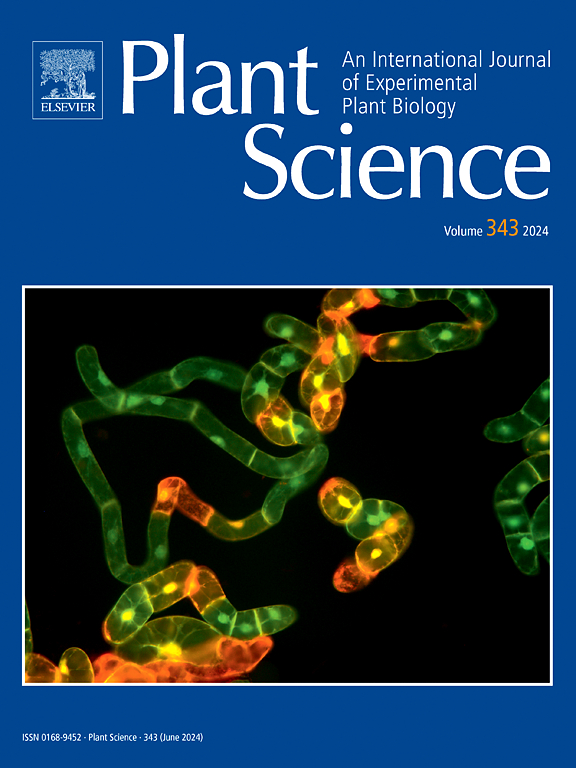Study on adventitious root induction and endogenous hormone dynamics during cutting propagation of Distylium chinense
IF 4.2
2区 生物学
Q2 BIOCHEMISTRY & MOLECULAR BIOLOGY
引用次数: 0
Abstract
Distylium chinense has strong ecological adaptability and high ornamental value, which should have broad application prospects in urban landscaping. However, its low cutting rooting rate and slow rooting speed, as well as limited varietal numbers, have hindered its promotion and application in landscape. This study aims to reveal the development characteristics of adventitious roots (AR) and the regulation mechanism of endogenous hormones during the cutting propagation. Through cutting propagation and paraffin section technology, combined with immunohistochemical localization and hormone quantitative analysis, the morphogenesis of cuttings and the dynamic changes of endogenous hormones were comprehensively analyzed. The study found that the development of AR experienced three stages: induction period, expression period and elongation period, and the root primordium originated from vascular cambium, phloem, cortex and callus. Indoleacetic acid (IAA) and abscisic acid (ABA) signals accumulated in different tissues with the development of AR. IAA content showed a trend of ' decrease-increase ', zeatin riboside (ZR) and gibberellin (GA3) content showed a trend of ' decrease-increase-decrease ', while ABA content showed a trend of ' increase-decrease-increase ' in the treatment group, which was compared with the ' decrease-increase ' trend of the control group. These results not only indicate that the development process of AR is closely related to the temporal and spatial changes of endogenous hormones, but also provide a new theoretical basis for the cultivation of new varieties and industrial production of D. chinense.
千屈菜具有较强的生态适应性和较高的观赏价值,在城市园林绿化中应具有广阔的应用前景。然而,其切根率低、生根速度慢,且品种数量有限,阻碍了其在园林绿化中的推广应用。本研究旨在揭示不定根(AR)在扦插繁殖过程中的发育特征及内源激素的调控机制。通过扦插繁殖和石蜡切片技术,结合免疫组化定位和激素定量分析,全面分析了扦插苗的形态发生和内源激素的动态变化。研究发现,AR的发育经历了诱导期、表达期和伸长期三个阶段,根原基起源于维管束韧皮部、韧皮部、皮层和胼胝体。随着 AR 的发育,吲哚乙酸(IAA)和脱落酸(ABA)信号在不同组织中积累。与对照组的 "减少-增加 "趋势相比,处理组的IAA含量呈 "减少-增加 "趋势,玉米素核苷(ZR)和赤霉素(GA3)含量呈 "减少-增加-减少 "趋势,而ABA含量呈 "增加-减少-增加 "趋势。这些结果不仅表明AR的发育过程与内源激素的时空变化密切相关,而且为金线莲新品种培育和产业化生产提供了新的理论依据。
本文章由计算机程序翻译,如有差异,请以英文原文为准。
求助全文
约1分钟内获得全文
求助全文
来源期刊

Plant Science
生物-生化与分子生物学
CiteScore
9.10
自引率
1.90%
发文量
322
审稿时长
33 days
期刊介绍:
Plant Science will publish in the minimum of time, research manuscripts as well as commissioned reviews and commentaries recommended by its referees in all areas of experimental plant biology with emphasis in the broad areas of genomics, proteomics, biochemistry (including enzymology), physiology, cell biology, development, genetics, functional plant breeding, systems biology and the interaction of plants with the environment.
Manuscripts for full consideration should be written concisely and essentially as a final report. The main criterion for publication is that the manuscript must contain original and significant insights that lead to a better understanding of fundamental plant biology. Papers centering on plant cell culture should be of interest to a wide audience and methods employed result in a substantial improvement over existing established techniques and approaches. Methods papers are welcome only when the technique(s) described is novel or provides a major advancement of established protocols.
 求助内容:
求助内容: 应助结果提醒方式:
应助结果提醒方式:


